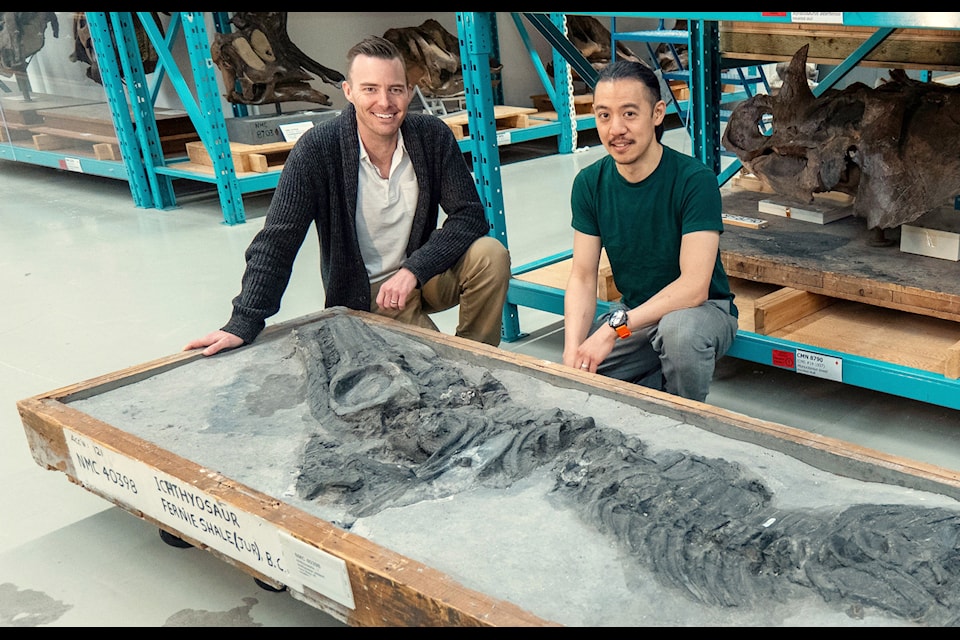A fossil that was discovered over a century ago on the outskirts of Fernie, B.C is back in the public spotlight, following a scientific breakthrough that declares it among the most complete specimens of its kind in North America.
Tom Prentice discovered the fossil of an ichthyosaur in 1916 while fishing in the Elk River, near Fernie, and it has been housed in the Canadian Museum of Nature in Ottawa ever since. New research, undertaken by Museum staff and paleontology experts, has revealed it's the most complete ichthyosaur skeleton from the Early Jurassic period in North America.
Its new scientific name fernatator prenticei, references the location it was found in and the surname of the man who discovered it. The first word translates to "Fernie Swimmer."
Ichthyosaurs were fearsome marine reptile predators that prowled the oceans from the Early Triassic to the beginning of the Late Cretaceous, and peaked approximately 250 to 175 million years ago. Their diet consisted of fish, cephalopods like squid and cuttlefish, and even their own kind.
They had a superficial resemblance to dolphins, although the two animals are not related.
"Dolphins are mammals and ichthyosaurs were reptiles, so there's no evolutionary link there," explained museum palaeobiologist Dr. Jordan Mallon. "[It's] a prime example of convergent evolution, where you have two very different species converging on the same body plan because they evolved to fill a very similar ecological niche."
Ichthyosaurs share anatomical similarities with ichthyosaurus and temnodontosaurus, but have some unique features that distinguish them, including a longer maxilla that holds their upper teeth, and a unique bony joint at the back of their eye socket.
Research undertaken by retired Geological Survey of Canada scientist Terry Poulton and independent researcher Murray Edmunds, indicated the Fernie Swimmer is 187 to 190 million years old, based on the age of the ammonites attached to the skeleton.
The specimen is 2.8 metres long, although the complete skeleton was probably closer to 3.5 to 4 metres long.
While thousands of partial and complete Early Jurassic ichthyosaur skeletons have been found in the U.K and Germany, finds in North America are more rare. In fact, Fernie Swimmer is only the second such taxon recognized in Canada.
"Those Early Jurassic rocks that we find these animals in are much better exposed in Europe. Ichthyosaurs are common over there and we know a lot about them from that time and that place," said Mallon.
"Here in North America, those rocks are much more poorly exposed, and as a result, are not as well understood. We don't know much about the fossil fauna from that time period here," he added.
Mallon remains hopeful the find will provide data and new understanding of the evolution and diversity of prehistoric marine reptiles.
After Prentice's discovery, the skeleton was collected by Crowsnest Pass Coal Company and displayed in its Fernie office. In 1917, renowned fossil hunter Charles M. Sternberg collected it and shipped it to the Canadian Museum of Nature, where it remains to this day.
The skeleton lay in the museum's collection for decades, but it didn't really capture much attention until 2022, when Mallon showed a picture of the specimen to renowned ichthyosaur researcher Dr. Judy Massare at a palaeontology banquet. Massare was intrigued and Mallon invited her to come visit the museum to view it. Massare was the lead researcher of the scientific paper in Paludicola.
"When I started at the museum 10 years ago, I saw this animal sitting on the shelf and I did a quick perusal of the scientific literature on it, and found nothing. I recognized that it's a relatively complete ichthyosaur from the Jurassic Period, which are relatively uncommon here," Mallon recalled.
"Many museums in North America don't have a big collection of ichthyosaurs, so we aren't frequently visited by ichthyosaur researchers, who would have an eye for the significance of the specimen," he said.
"It speaks to importance of museum collections, where we conserve these things for 100 years or more, only for someone to be able to recognize the importance much much later," Mallon added.



